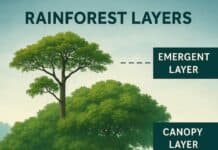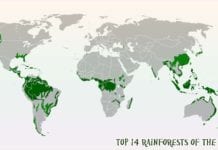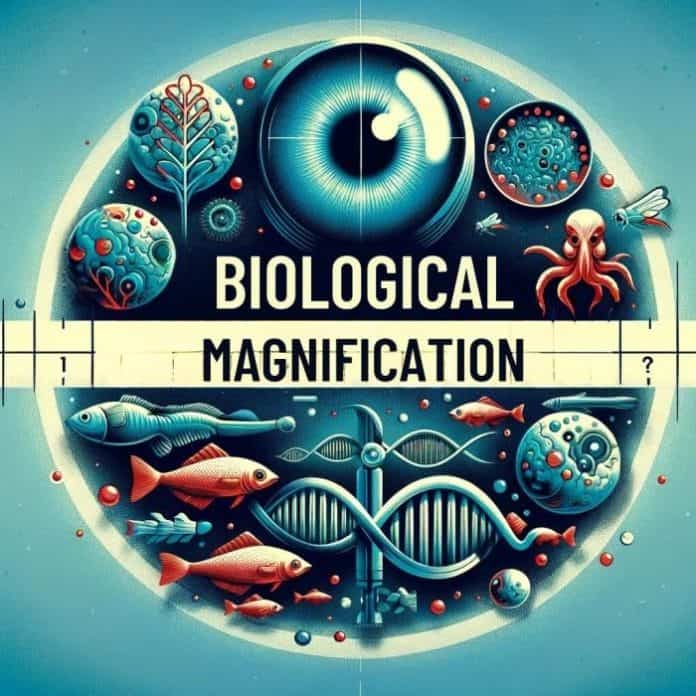
As toxins make their way through Food Chains, they can accumulate in increasing concentrations in organisms higher up the chain through a process called Biological Magnification. This results in apex predators like tuna, bald Eagles, and even humans accumulating extremely high toxin loads, even if the concentration in the environment is low. Understanding how biological magnification works and its impacts on ecosystems and human health is key to better-protecting wildlife and ourselves.
Biological magnification occurs when toxins accumulate in an organism and are passed on in even higher concentrations to the next trophic level that consumes the contaminated prey. Certain attributes of toxins and the feeding relationships in a food chain enable their increasing magnification to potentially dangerous levels in top predators.
While DDT (dichlorodiphenyltrichloroethane), a pesticide once heavily used in agriculture, and mercury are two infamous examples, biological magnification is an issue for many environmental contaminants working their way through trophic webs worldwide.
In this comprehensive guide, we will unpack what biological magnification is, what causes it, how it works, key examples of impacts across ecosystems, and how it might be reduced. Understanding the biological magnification process and its ecological effects can better address this complex issue that interconnects environmental, animals, plants and human health.
Table of Contents
- What is Biological Magnification?
- How Biological Magnification Occurs
- Causes of Biological Magnification
- Key examples of Biomagnification
- Impacts of Biological Magnification on Humans
- Impacts on Ecosystems
- Impacts on Animals
- Impacts on Plants
- Fun Facts About Biological Magnification
- 1. Extreme Bioaccumulation in Fish
- 2. Metals Mostly Avoided
- 3. Measuring Magnification Factors
- 4. Predicting High Accumulators
- 5. Tools for Assessing Biomagnification
- 6. TMFs Endorsed as Key Metric
- 7. Latitude Dependent Magnification
- 8. Neurotoxic Impacts
- 9. Trophic Transfer Terrestrially
- 10. Complex Considerations
- Reducing Biological Magnification
- Frequently Asked Questions
- What is the biomagnification definition?
- How do substances that biomagnify move up the aquatic food web?
- What role do pesticides play in Biomagnification in aquatic ecosystems?
- What are some common substances that biomagnify in marine food chains?
- How does Biomagnification affect wildlife and human health?
- Can the process of Biomagnification be reversed or mitigated?
- What is the difference between bioaccumulation and Biomagnification?
- How can individuals reduce their exposure to substances that biomagnify?
- Conclusion
What is Biological Magnification?
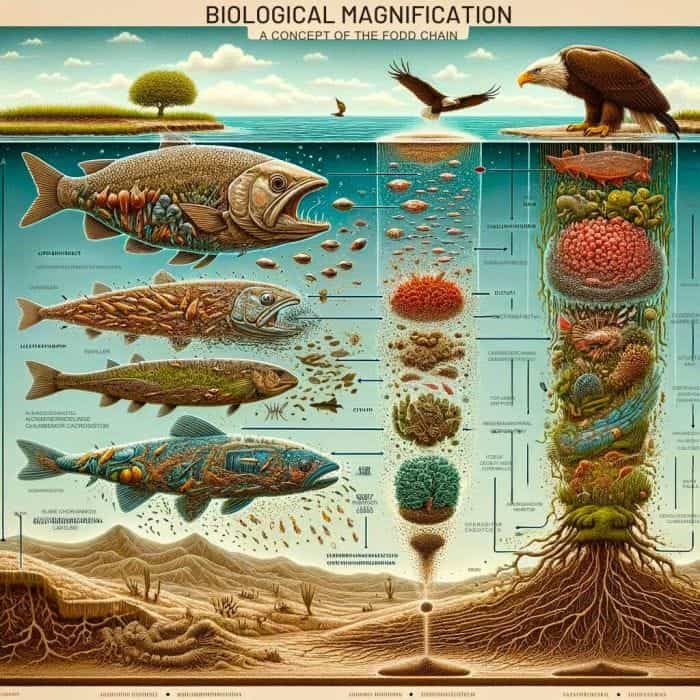
Biological magnification refers to the process by which persistent toxins accumulate in increasing concentrations up each step of the food chain. Also termed bioamplification or Biomagnification occurs when an organism absorbs a toxin faster than it can be metabolized and excreted. The contaminant accumulates in body tissues and is magnified with each trophic transfer from prey to predator.
- Even if environmental concentrations of a toxin are low, biological magnification along food chains can result in exceptionally high amounts condensed in apex predators. For instance, while DDT concentrations of just 0.000003 ppm have been measured in seawater, levels exceeding 30 ppm have been found in sharks –a biomagnification of over 10 million times!.
- Biological magnification occurs because toxins accumulate in fatty tissues faster than an organism can efficiently metabolize and excrete them. Since predators consume large quantities of contaminated prey, they amass greater toxin burdens than their prey. This culminates in extreme bioaccumulation at the tops of food chains, where the highest-level consumers like tuna, eagles, and polar bears carry heavy toxin loads.
Understanding the mechanics behind biological magnification is key to elucidating why and how it occurs. In the next section, we will unpack the step-by-step process of bioamplification through food chains.
How Biological Magnification Occurs
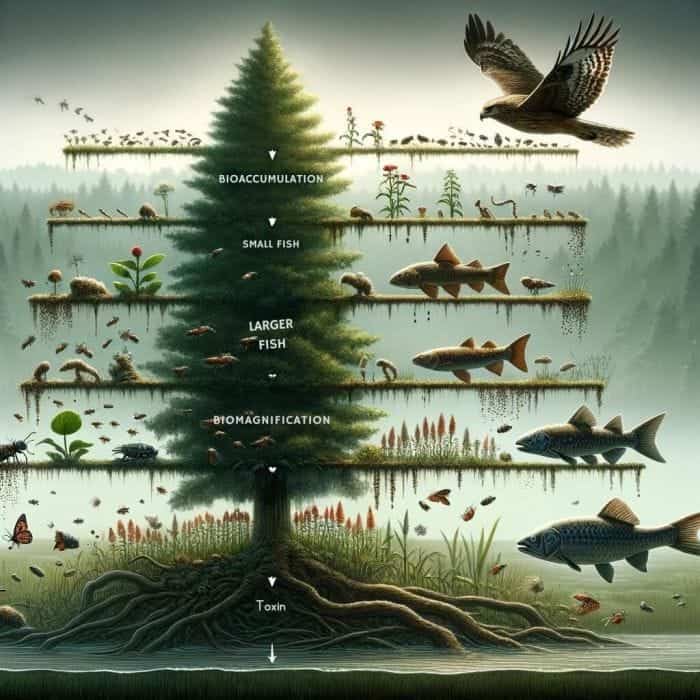
Biological magnification takes place step-wise up food chains through processes of bioaccumulation and Biomagnification at each trophic level transfer. Several key characteristics of persistent toxins and feeding relationships enable extreme bioamplification to the top predators.
- Bioaccumulation is the net accumulation of toxins in an organism from its food, water, air, or surroundings over time. Toxins accumulate when the rate of intake exceeds the rate of excretion/metabolism by the body. Many harmful compounds like heavy metals, pesticides, and other organic pollutants accumulate in fatty tissues and blood.
- Biomagnification then occurs when contaminated prey is consumed by a predator. The toxins accumulate to a higher concentration in the predator than in the prey at the lower trophic level. This happens because the predators eat many preys, and toxins from them all combine to “magnify” in the consumer’s tissues.
Several key traits of persistent environmental toxins enable this stepwise trophic transfer and increasing bioamplification up food chains:
- Fat solubility Allows dissolution in fatty tissues which accumulate high concentrations.
- Slow degradation Persist for long periods without breaking down.
- Low water solubility Do not dissolve easily in water, so remain in organisms.
- Limited metabolic breakdown Not easily excreted or deactivated by organisms.
Combined with feeding relationships where predators consume many preys and live longer to amass greater burdens, these toxicity traits culminate in extreme bioamplification of food chains. The top predators bear the largest toxin loads despite minimal environmental concentrations.
Causes of Biological Magnification
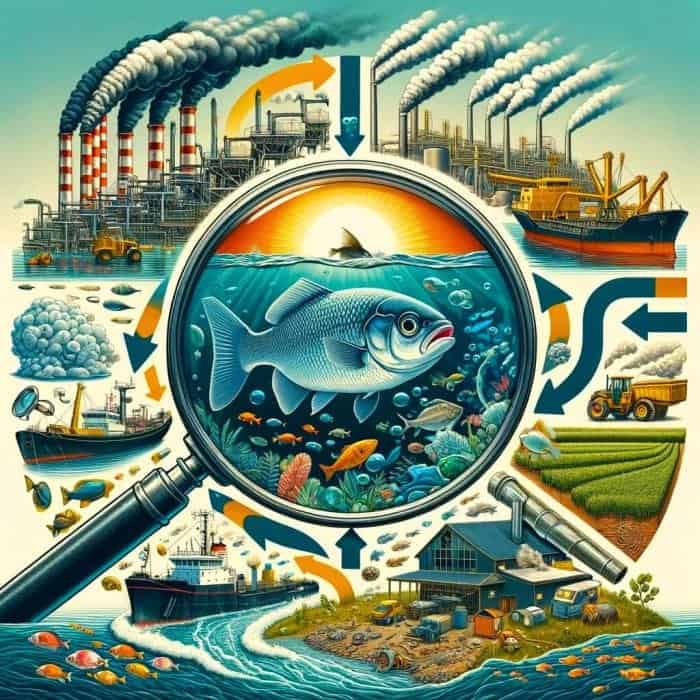
Several key factors enable toxins to biomagnify to extreme levels up food chains from environmental sources to top predators:
Toxin Sources
Contaminants that bioaccumulate originate from various sources across landscapes and waterscapes. These include:
- Pesticides: Insecticides, herbicides, fungicides Ex: DDT, dieldrin.
- Industrial compounds: PCBs (polychlorinated biphenyls), dioxins, furans Ex: transformer fluids.
- Fossil fuel emissions: PAHs (Polycyclic Aromatic Hydrocarbons), combustion byproducts.
- Waste products: Excreted medications, plastics, heavy metals.
- Agricultural runoff: Nutrients, pharmaceuticals, ammonia.
Many synthetic compounds used widely across our economies ultimately find their way into natural systems. Persistent ones resist degradation and provide chronic exposure.
Persistence
If toxins rapidly degrade, there is less time for bioaccumulation. However, stubborn compounds that experience little breakdown even after years magnify greater concentrations through long-term Biomagnification. For example, DDT pesticide residues from decades prior are still cycling.
Solubility & Mobility
Compounds must first dissolve into bodily fluids and Cell Membranes to accumulate in organisms and transfer chains. Fat-soluble compounds like organochlorine pesticides and PCBs readily traverse lipid-rich membranes and Cell Walls to dissolve in fatty tissues, fluids, and organs. Other destructive yet water-soluble toxins like mercury also permeate blood, membranes, and biological barriers to accumulate in tissues.
Metabolic Inability
Most organisms lack specialized metabolic pathways to break down foreign synthetic compounds not endemic to their Ecology. Without detoxification mechanisms, they cannot degrade nor excrete bioaccumulated toxins efficiently. Moreover, even essential metals like copper and iron become toxic at high concentrations if an excess accumulates that organisms cannot regulate properly.
Chronic Exposure
A major enabling factor is long-term chronic exposure over months, years, or generations. Toxins amass at concentrations orders of magnitude above ambient levels as animals forage, breathe, and drink in contaminated sites. Bioaccumulation thereby escalates with more time and exposure across delicate developmental stages. Even essential nutrients like selenium become damaging when concentrated excessively over time.
This combination of pollution sources, stubborn compounds, and Physiological incapacity culminates in increasing biological magnification and extreme bioaccumulation in organisms higher up food chains. Top predators, thereby, bear the worst toxin burdens.
Key examples of Biomagnification
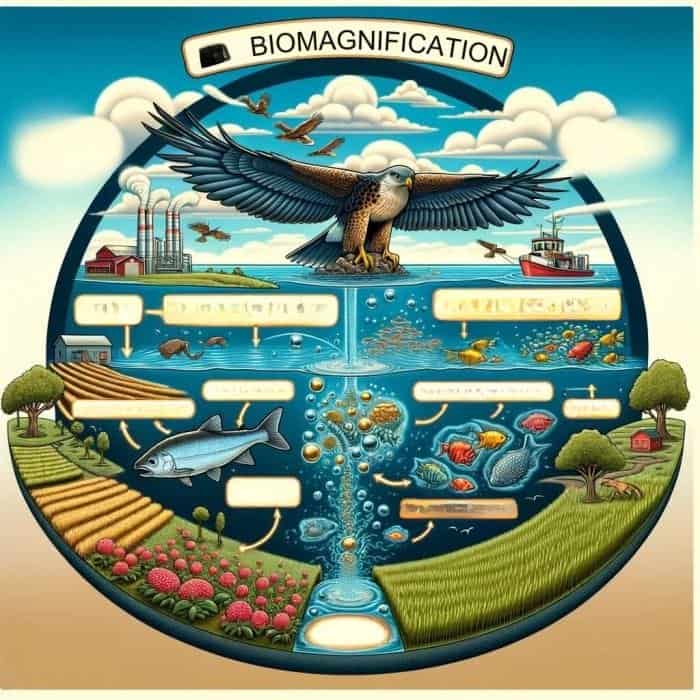
DDT Magnification in Birds of Prey
The pesticide DDT infamously thinned raptor eggshells and decimated bald eagle populations by the 1950-60s from magnification in the aquatic food chains they consumed. Though banned decades ago, DDT residues persist and concentrate on aquatic arthropods, fish, and Birds, with levels in Falcons reaching up to 48 ppm dry weight.
Methylmercury Biomagnification in Fish
Microbes convert inorganic mercury to organic methylmercury that bioaccumulates in aquatic food webs. Methylmercury concentrates over a millionfold from water to predatory fish like sharks and marlins. Fish consumption advisories caution limiting intake of larger, longer-living predator fish, which biomagnify the highest mercury loads.
Shellfish Toxin Accumulation
Toxic algal blooms generate shellfish toxins like domoic acid, saxitoxins, brevetoxins, and azaspiracids, concentrating in bivalves. These toxins can be extremely dangerous when magnified in shellfish, leading to amnesic shellfish poisoning when consumed by humans.
Agricultural Fertilizer Contamination
Runoff of nitrogen and phosphorus fertilizers into waterways drives Algae blooms and eutrophication, which indirectly magnifies additional toxins in aquatic life as an impact. Livestock manure from concentrated feedlots also releases contaminants, including antibiotics and hormones that concentrate through biological magnification.
In addition to these examples, biological magnification occurs globally for various pesticides still used today and emerging contaminants of concern from pharmaceuticals to microplastics. The ability of foreign toxins to magnify to concentrations far above ambient levels in ecosystems makes biological magnification a huge environmental issue.
Impacts of Biological Magnification on Humans
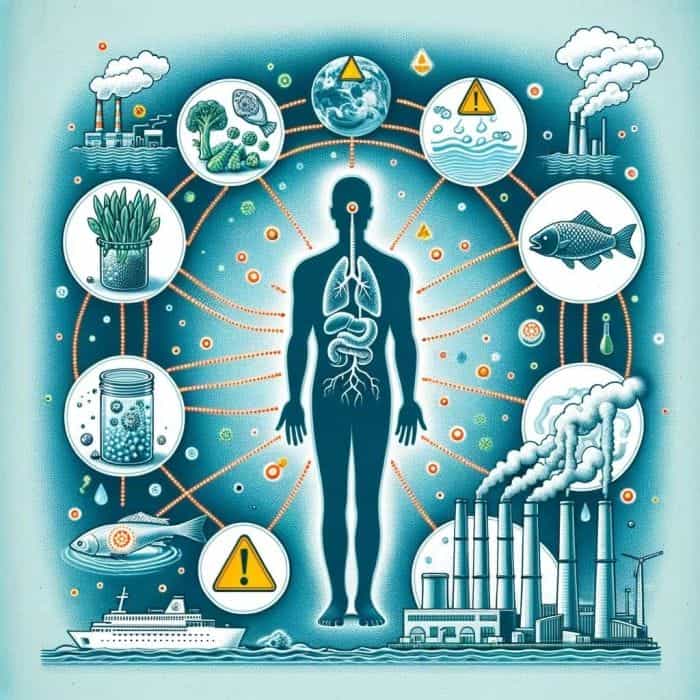
The extreme bioaccumulation of toxins to elevated concentrations in organisms, which humans harvest and consume, can pose health risks by transferring high chemical loads to our bodies.
Seafood Consumption
Fish and shellfish accumulate high burdens of methylmercury, PCBs, dioxins, organochlorine pesticides, and other toxins from aquatic food chains. Government guidelines on safe weekly seafood consumption have been developed based on toxin magnification levels. Ex: limiting tuna, which concentrates over a million times the mercury levels in seawater.
Terrestrial Meat & Dairy
Livestock like cattle and Chickens fed contaminated grains, fishmeal, and bioproducts accumulate organic chemical pollutants into milk and meat that ultimately transfer to human diets. For example, dioxin levels in the Vietnam War defoliant Agent Orange magnified upwards from 11 ppm in forest plants sprayed to 242 ppm in chickens fed the vegetation.
Reliance of Top Predators
Species that amass high toxin burdens through biological magnification comprise key traditional and market foods for communities, such as whale, seal, fish, and bird staples for circumpolar indigenous groups. Loss of these food sources threatens nutrition, health, and cultural lifeways.
Understanding how biological magnification concentrates toxins like heavy metals, pesticide residues, and emerging contaminants in different foods guides safer dietary choices to minimize harm prudently. It also urges us to curtail avoidable environmental releases to protect the ecosystem and human health from excessive chemical exposures unwittingly amassed through what nature eats.
Impacts on Ecosystems
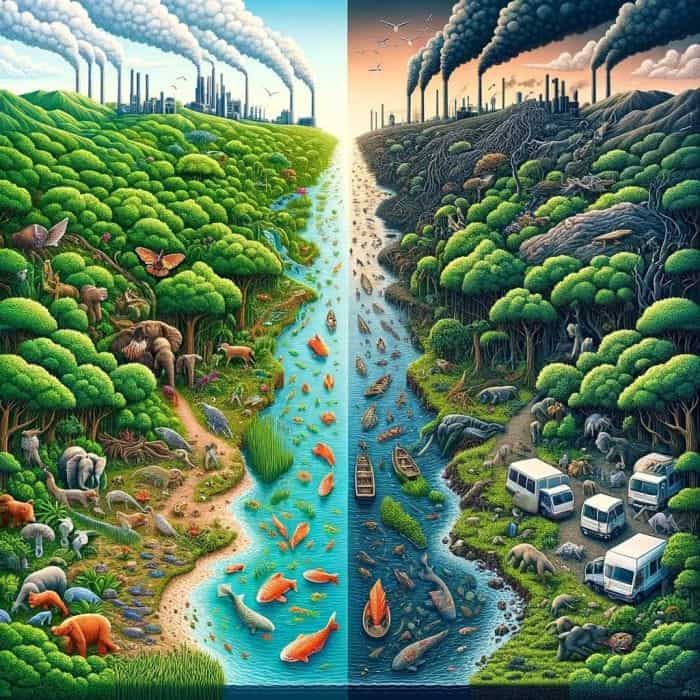
Beyond human health, biological magnification creates sublethal to severe impacts cascading through food webs due to systemic accumulation.
Population Declines
Reproductive toxicity from endocrine disruption and developmental abnormalities has led to catastrophic collapses of top predators like DDT poisoning of raptors. Still, ongoing population declines result from chronic low-dose exposures accumulating through magnification.
Behavioral & Neurological Effects
Many bioaccumulated toxins mediate adverse effects through neurotoxicity and disrupting cellular communication. Resulting wildlife examples span from impaired navigation in lead-burdened condors to mistaken nest identification in DDT-poisoned eagles.
Disease Susceptibility
Compromised immunity from certain accumulated chemicals like persistent organic pollutants weakens resistance to bacterial, viral, and parasitic diseases. Toxicity also stresses system functioning. Combined, this exacerbates morbidity and mortality rates from contagious pathogens and non-communicable diseases.
Food Web Disruption
Top predator loss to pollution can trigger downward ecological cascades throughout systems. Moreover, most chemical impacts remain invisible until extreme magnification makes them evident in species of serious concern like whales, panthers, or raccoons. However, pervasive sublethal effects likely still harm populations and ecosystem resilience at lower thresholds.
The vast impacts of biological concentrating environmental toxins make it an enormous yet underrated issue for properly supporting biodiverse, vibrant, and functional ecological communities across terrestrial, freshwater, and marine habitats.
Impacts on Animals
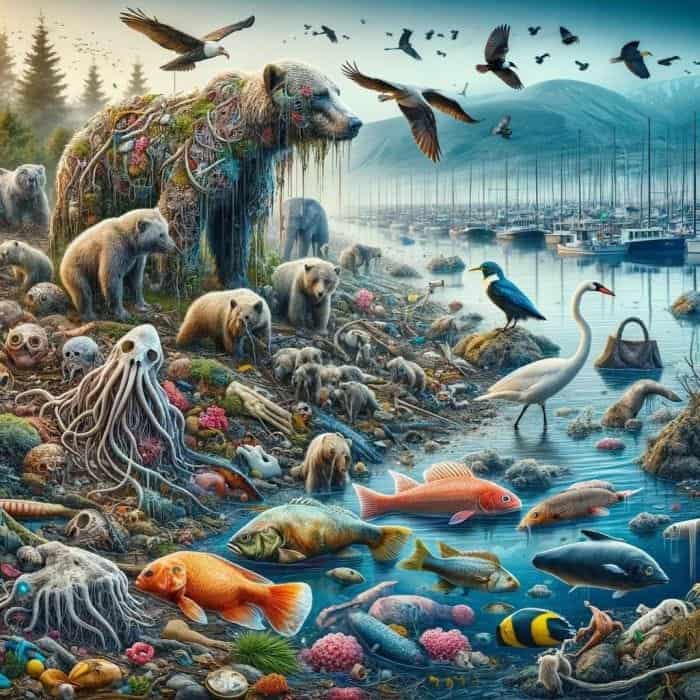
Beyond population-level ecosystem effects, biological magnification also exerts severe toxicity burdens on individual wildlife health through bioaccumulation in tissues.
Reproductive Impacts
Many persistent pollutants disrupt delicate endocrine systems, resulting in fertility issues, congenital disabilities, and developmental abnormalities. Egg-thinning and impaired reproduction decimated bird populations that consumed magnification levels of DDT in aquatic food chains. Intersex features and reproductive organ deformities arise from hormone-disrupting chemicals increasing in exposed species ranging from fish and turtles to panthers and Seals.
Disease Vulnerability
High toxin loads stress physiology, suppress immune function, and create neurological impacts that heighten susceptibility to pathogens, Parasites, and other diseases. Everything from cancer risk to infectious disease mortality escalates in contaminated wildlife, also increasing the chances of zoonotic spillover diseases infecting human populations.
Tissue & Organ Damage
Bioaccumulated metals like mercury and cadmium directly damage organs like the liver and kidneys involved in detoxification pathways. Many persistent chemicals elicit cellular oxidative stress and free radical damage. Others have an affinity for Proteins and Lipids that comprise structural cellular matrices and membranes. The results span organ failures to tumors in animals.
By concentrating otherwise relatively low environmental levels too often staggeringly high internal doses, biological magnification exacts pernicious damages onto individual health and well-being at the top of food chains.
Impacts on Plants
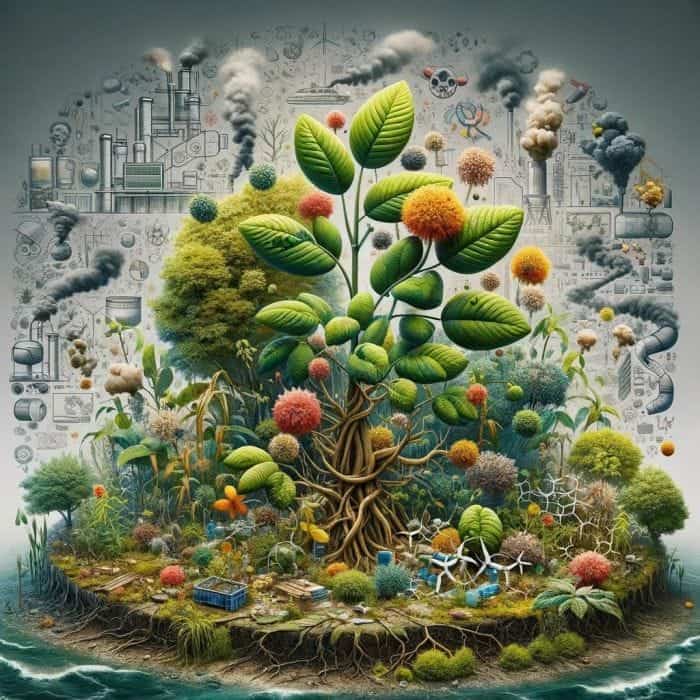
While animals bioaccumulate toxins in fatty tissues, plants concentrate contaminants from soil and water into roots, stems, leaves, and seeds.
Uptake & Accumulation
Through root systems or leaf stomata, plants absorb and transport anthropogenic chemicals, heavy metals, emerging contaminants, radioactive isotopes, and other pollutants from growth substrates into plant tissues. Contaminants are concentrated in cell walls, vascular fluids, and organs.
Growth & Developmental Impacts
Phytotoxic effects of accumulated toxins include DNA damage, oxidative stress, enzymatic inhibition, and protein dysfunction, resulting in biomass decline, stunted growth, leaf chlorosis, and necrosis. Plant reproduction can also suffer from aborted flowers, sterility, and reduced seed viability.
Yield & Crop Safety
Reduced agricultural yields pose food security risks, while crop contamination raises food safety issues for human consumption. For example, rice efficiently absorbs arsenic from tainted irrigation water and soil, resulting in cereal grain concentrations exceeding national safety limits.
Land Restoration Challenges
Site remediation requires reducing bioavailable fractions of contaminants. However, plants can complicate cleanups through massive uptake volumes and extensive root zones that accumulate high pollutant concentrations into biomass requiring removal.
Understanding the breadth of biological impacts across both plant and animal taxa is key to clarifying contamination burdens from biomagnification processes that permeate ecosystems.
Fun Facts About Biological Magnification
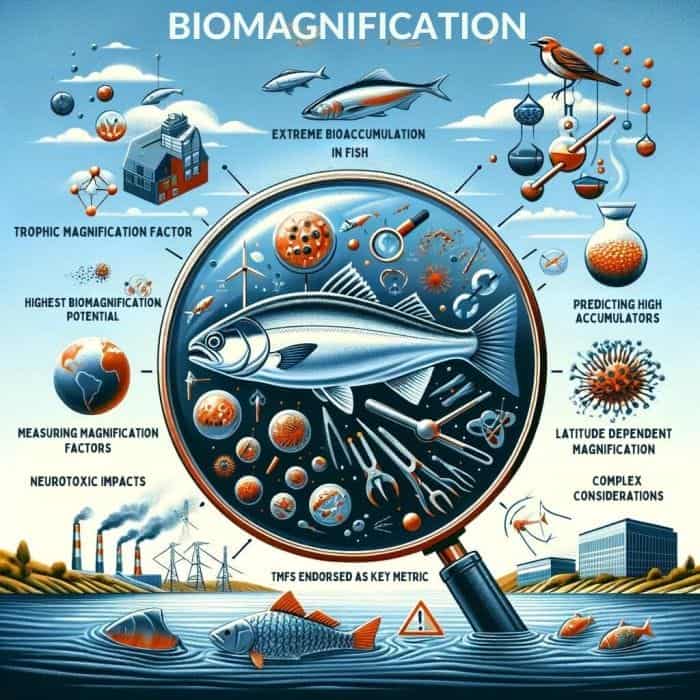
While a serious issue, biological magnification also creates fascinating phenomena, from extreme bioaccumulation ratios to unusual impacts only evident through magnification.
1. Extreme Bioaccumulation in Fish
A study utilizing fugacity models of contaminant absorption in fish gastrointestinal tracts underscored the significance of biological magnification in environmental risk assessments. Tracing the journey of pollutants through aquatic food chains revealed the potential for extreme bioaccumulation in higher predators.
2. Metals Mostly Avoided
Unlike notorious mercury, which is clearly biomagnified, most metals are regulated and excreted by organisms – not accumulated. So, while organic mercury shows severe magnification, other metals demonstrate little to none in marine systems.
3. Measuring Magnification Factors
Trophic Magnification Factors (TMFs) measure the bioaccumulation in top predators to confirm and quantify biological magnification within specific ecosystems. Studying TMFs thus provides valuable illumination of the biomagnification process for hydrophobic substances.
4. Predicting High Accumulators
A global analysis found the highest biomagnification potential lies with slowly metabolized organic chemicals that are moderately hydrophobic. This suggests a pattern among trait-based bioaccumulation risks across diverse ecosystems.
5. Tools for Assessing Biomagnification
Metrics like TMF (Trophic Magnification Factor) and BMF (Biomagnification Factor) successfully identified significant biological magnifiers from PBDE (Polybrominated Diphenyl Ethers) flame retardants to PCB coolants to methylmercury in coastal food webs. This highlights their usefulness in evaluating environmental pollutant magnification.
6. TMFs Endorsed as Key Metric
Recent workgroups recognized tropic magnesium factors (TMFs) as a vital measurement for characterizing chemical bioaccumulation – holistically capturing the essence of food web biomagnification.
7. Latitude Dependent Magnification
A worldwide mercury meta-analysis revealed biomagnification slopes representing degrees of magnification were significantly and positively correlated with latitude. This suggests geographical variances in mercury biomagnification processes globally.
8. Neurotoxic Impacts
Biomagnification of the neurotoxin BMAA (Beta-Methylamino-L-alanine ) through the Guam ecosystem has been associated with increased neurodegenerative disease among the native Chamorro people. An alarming case study on health risks of biochemical magnification.
9. Trophic Transfer Terrestrially
A food chain study tracing lichen to caribou to Wolves demonstrated how perfluorinated compounds bioaccumulate in Arctic terrestrial ecosystems. It profiled the distinct magnification behaviors of PFCAs (Perfluorocarboxylic Acids) and PFSAs (Perfluorosulfonic Acids) transferring trophically.
10. Complex Considerations
Accurately modeling Biomagnification relies on holistically factoring ecological attributes, food web dynamics, study parameters, and more. Amplified concentrations integrate many complex variables, requiring meticulous consideration to evaluate them properly.
Reducing Biological Magnification
Biological magnification stems largely from avoidable environmental contamination, so targeted pollution prevention and ecosystem restoration can reduce bioaccumulation risks.
Restrict Toxic Releases
Comprehensively limiting industrial, agricultural, and urban effluents to block unnecessary contamination prevents amplification pathways from initiating. Legal discharge limits uniquely tailored to magnification potential rather than just ambient toxicity would enhance protection.
Promote Degradability
Prioritizing rapid natural degradation in chemical designs and environmental levels below physiological assimilation rates minimizes bioaccumulation likelihood before magnification escalates.
Restore Habitats
Damaged ecosystems wide open to pollution exposures facilitate magnification. But healthy, biodiverse, fully-functioning habitats with dense vegetation and low runoff buffer and cycle some toxins. Restoration strengthens resilience.
Advance Regulations
Outdated policies inadequately safeguard wildlife and human health against the modern diversity of contaminants subject to biological magnification. Updating standards to address bioaccumulation potential would incentivize needed market transitions.
Monitor Uniquely Vulnerable Species
Key indicator species with high toxin loads hint at wider biomagnification risks. Expanding biomonitoring to additional taxa monitors emerging threats. Meanwhile, protecting the most vulnerable species confers umbrella-like cover, safeguarding entire linked food webs.
Promote Sustainability
Harvesting lower on food chains for staple Crops and animal-based foods ultimately further limits magnification exposures to people. Guiding markets and subsidies towards ecological sustainability enhances health and conservation alike.
Frequently Asked Questions
What is the biomagnification definition?
Biomagnification, often referred to as biological magnification, is the process by which the concentration of a substance, such as toxic chemicals or pollutants, increases in the bodies of organisms higher in the food chain through ingesting other organisms that have absorbed these substances. This process typically occurs in aquatic ecosystems and significantly impacts wildlife and human health.
How do substances that biomagnify move up the aquatic food web?
Substances that biomagnify move up the aquatic food web primarily through the diet of organisms. When aquatic organisms at a lower food chain level ingest toxic substances from their environment, these substances accumulate in their bodies. Predators in the food chain then eat these contaminated organisms, resulting in a higher concentration of the toxic substance in their bodies. This cycle continues, leading to significant increases in toxic substance concentration at each successive food chain level.
What role do pesticides play in Biomagnification in aquatic ecosystems?
Pesticides play a significant role in Biomagnification in aquatic ecosystems. When pesticides are used in agriculture or urban settings, they can wash off the land during rainstorms and flow into aquatic ecosystems. Aquatic organisms absorb these pesticides, which begin to biomagnify as they move up the food chain. Toxic chemicals such as polychlorinated biphenyls (PCBs) and DDT are examples of pesticides known to biomagnify, leading to harmful effects on marine food chains and aquatic organisms.
What are some common substances that biomagnify in marine food chains?
Common substances that biomagnify in marine food chains include polychlorinated biphenyls (PCBs), chlorinated pesticides like DDT, heavy metals such as mercury and lead, and other industrial chemicals. These toxic substances are persistent in the environment. They can accumulate in the tissues of aquatic organisms, leading to higher concentrations in the food chain.
How does Biomagnification affect wildlife and human health?
Biomagnification affects wildlife and human health by exposing organisms, including humans, to increased levels of toxic chemicals and substances as they move up the food chain. In wildlife, this can lead to reproductive failures, birth defects, developmental issues, and even death. In humans, consuming contaminated seafood or aquatic products can result in serious health problems, including damage to the Nervous System, reproductive and developmental problems, and an increased risk of cancer.
Can the process of Biomagnification be reversed or mitigated?
While the process of Biomagnification itself cannot be fully reversed in a short period due to the persistence of many biomagnifying substances in the environment, efforts can be made to mitigate its harmful effects. Reducing the use of persistent toxic chemicals, improving waste management practices, and cleaning up contaminated ecosystems can help decrease the levels of these substances in aquatic ecosystems and, by extension, in the food chain. Additionally, monitoring and regulating the levels of known biomagnifying substances can help protect wildlife and human health.
What is the difference between bioaccumulation and Biomagnification?
The main difference between bioaccumulation and Biomagnification lies in their scope and process. Bioaccumulation refers to the increase in the concentration of a substance in individual organisms over time due to absorption from the environment faster than it is metabolized or excreted. Biomagnification, on the other hand, refers to the sequential increase in concentration of a substance through the food chain, affecting organisms higher in the food chain. While bioaccumulation occurs within a single organism, Biomagnification occurs across multiple levels of the food chain.
How can individuals reduce their exposure to substances that biomagnify?
Individuals can reduce their exposure to substances that biomagnify by consuming lower-risk seafood and aquatic products, minimizing the use of pesticides and chemicals in their homes and Gardens, properly disposing of hazardous waste to prevent contamination of water bodies, and supporting environmental policies that aim to reduce pollution and protect aquatic ecosystems. Being informed about Biomagnification’s sources and effects can also help make safer choices to protect one’s health.
Conclusion
Biological magnification is an insidious phenomenon that concentrates toxins extracted from the environment to often dangerously high levels in organisms higher up the food chain. Even with low ambient environmental concentrations, bioaccumulation and Biomagnification ratchet up internal doses exponentially.
Key drivers range from pollution sources releasing stubborn toxins to trait-based factors that enable accumulation in fatty tissues and poor excretion. This increases toxin burdens transferred from prey to predator up entire food chains. Consequently, top predators carry the heaviest contaminant loads in their bodies, with humans often unintentionally assuming the highest risk positions through our food choices.
Myriad impacts cascade through ecosystems, population health, and individual well-being, from reproduction to immunity and neurofunction. Moreover, entirely unpredictable effects emerge when exotic synthetic compounds biomagnify in ways unforeseen by nature.
While complex root causes underpin the issue, from chemical non-degradability to food web structure, targeted prevention through source control and environmental stewardship can detoxify risks. Protecting the most vulnerable keystone species also buffers whole interlinked communities. Additionally, selecting lower food chain options offers some refuge.
Ultimately, the pervasive ability of obscure environmental toxins to infiltrate food webs and concentrate magnitudes higher in apex predators makes addressing biological magnification an imperative for restoring the balance between ecosystems and human activities.


